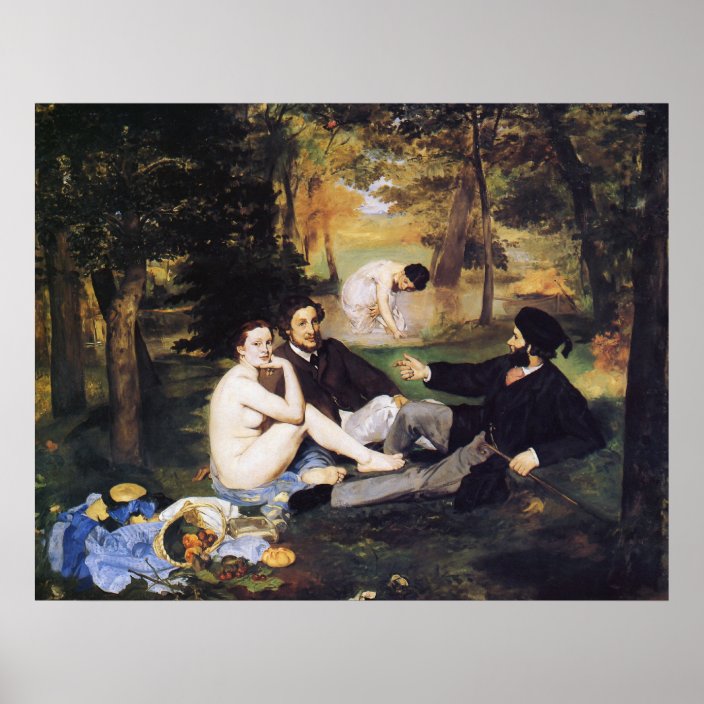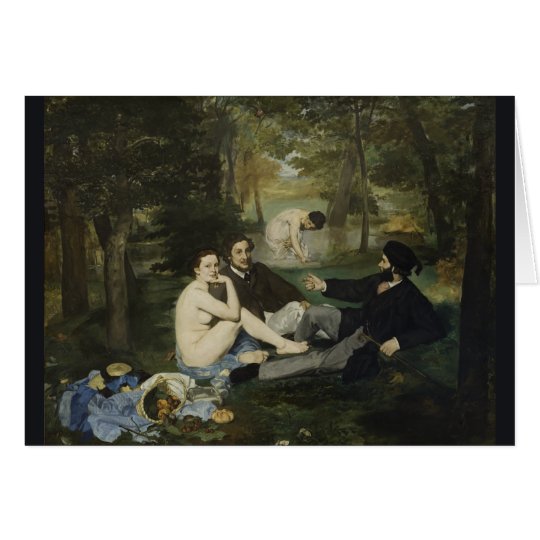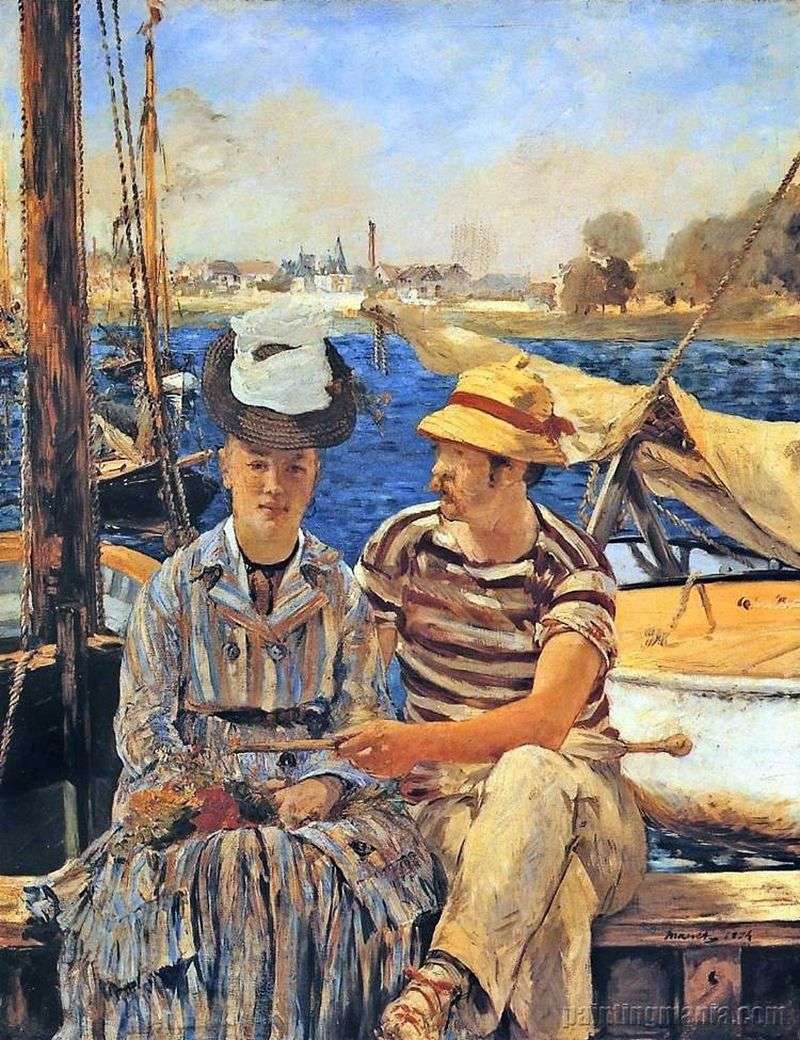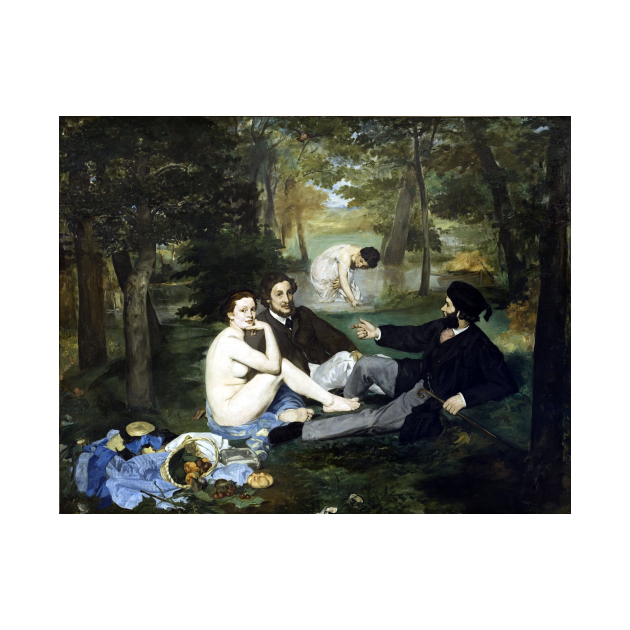

The tones, while nothing vibrant, do add to the surrealism of the piece.

#EDOUARD MANET LUNCHEON ON THE GRASS SKIN#
It is the sharp contrast between the announced skin of the female and the the dark, muffled surroundings that give Manet's work such a confronting subject. The controversy that ensued in 1863 was undoubtedly Manet's intended result.Ĭolour, tone, and value, though overshadowed, are technical elements that also carry some importance. Manet's painting is rich with mystery, suggestiveness, and surreal wonder. Rather than flatly announcing the nudity of the female, Manet also chose to include the abandoned clothes (which lay cast-aside amongst a picnic basket that has also been virtually ignored). One can try to decipher the conversation that might be taking place, but of much more immediate appeal is the pressured air of strange sexuality. Manet's "Le déjeuner sur l'herbe" depicts a nude female seated so assuredly amongst two men with absent personalities.

While one can easily manage interpretations on the technical levels, it is initially quite hard to get past the situation that unravels with such an auspicious nature. The most striking and intriguing element of this painting is the implied story. Some critics have analyzed this scene as one that may have been set up in a studio, rather than conducted out in nature.Ģ) Which elements are dominant? Are the lesser elements important? The men pay no attention to the fully exposed woman before them, the third man is gesturing at some one who seems uninterested, and none of the figures appear completely relaxed. Rather than acting naturally, they appear to be posing. While initially one would assume that Manet intended to capture a moment of social interaction, it instead seems as if the figures are suspended in time. But attention does hang between the lunch-goers nonetheless. In this way, attention is shifted away from the female nude. I also find myself following an implied pyramid form in the painting, which draws its base from the two bottom corners of the painting and rises up the the lady in the water. Implied lines appear in a number of ways, in the female's eyes, in the hand gesture of the man on the right, and even in the eyes of the man in the middle, who seems oddly unfocused in a potential conversation.

In the compositional sense, the figures are positioned very dominantly and central. In the background, brush strokes are made quite obvious and are even swirled and mixed together. Some of the composition is rendered very smooth, while the rest is quite unkempt. Texture is relayed in Manet's traditional style. Many have interpreted the lady in the water as a spirit, as she nearly seems to float above the heads of the lunch-goers. She doubles the size of the boat (which doesn't look too far away), and she even begins to impose on the central figures. While another figure is made clear in the background, her proportion is very irregular. Some of the brush strokes even appear to have been done in a vigorous and almost free-handed nature, which would hint at the improvisation that Manet may have employed whilst nearing the completion process of his work. As you travel deeper into the painting, brush strokes become much less detailed and refined. Volume and depth is inferred, but it is portrayed very irregularly. Within the bottom left corner of the painting Manet also inserts the element of still life, which contributes an added layer of colour. Dark greens, browns and blacks prevail, broken up of course by the skin of the figures. The element of colour is united with a very earthy theme. Oddly, little to no shadow is cast upon the figures. The canopy of leaves that undoubtedly hang above the figures cast a mismatch of tones upon the grass, while the figures, on the other hand, remain unaffected. Close inspection of the 19th-century work also reveals very inconsistent shadows. To contrast her, the surroundings are dark and somewhat obscured. While her eyes do draw interest as a focal point, it is her pale, milky skin that stands out noticeably in the scene. The viewer is immediately confronted with a fully nude, starkly lit female, who sits poised with two fully-clothed gentlemen on an apparent "luncheon". With Manet's "Le déjeuner sur l'herbe" comes an immediate sense of light and dark values. Le déjeuner sur l'herbe (The Luncheon on the Grass) by Édouard Manet 1862-1863.ġ) What elements appear in this work: line, light and value, colour, shape and volume, texture and pattern, space, time and motion, and chance, improvisation, and spontaneity?


 0 kommentar(er)
0 kommentar(er)
